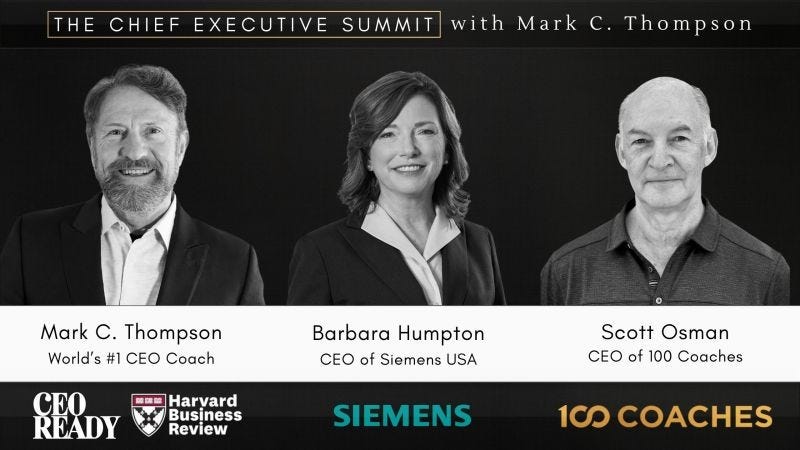Moments with Marshall
This past week, Jacquelyn and I had the opportunity to spend a couple of days with Marshall Goldsmith in Nashville. As always, we covered a wide array of topics, from MarshallGoldsmith.ai to the books he is co-authoring, to his newest idea–Marshall Goldsmith Advisors, a way to get one-on-one coaching from Marshall in partnership with his recommendations of experts to solve unique business problems. But my favorite part about time with Marshall is when the conversation inevitably turns to the topic of how we can live our lives to the fullest. And as always, Marshall combined deep insight with contrarian views to reveal profound truths. To live a full life, you have to leave before you are asked to leave, create space for new ideas, and then pick a new direction and embrace it.
Leaving before you are asked to leave may seem counterintuitive, but it's a powerful principle. Too often, we stay in roles, relationships, or situations long past their expiration date. We cling to the familiar, even when it no longer serves us or those around us. We are creatures of habit, and we like to be comfortable. But Marshall reminds us, you can either leave when they are asking you to stay (better) or when they are telling you to leave (worse). By proactively choosing to move on, we control our narrative and create space for new growth. This doesn't mean abandoning commitments or responsibilities; it's about recognizing when a chapter is coming to its natural end and we can find the courage to turn the page. In leadership, this means preparing a successor and then stepping aside to let fresh perspectives take the helm. In our personal lives, it could be about letting go of a relationship that has run its course, even if it's comfortable. By leaving on our terms, we open ourselves up to new possibilities and adventures.
Creating space for new ideas is essential for personal and professional growth. I’m amazed at how Marshall has continuously reinvented himself over the last several decades, never resting on his laurels and instead pushing his own boundaries into areas like AI, new ways to give back and teach others, and writing about topics he cares about. When we're constantly immersed in the day-to-day grind, it's easy to fall into patterns of thinking and behaving that limit our potential. By intentionally carving out time and mental space for reflection, learning, and exploration, we invite innovation and insight into our lives. This might mean setting aside dedicated time for reading, attending conferences or workshops, or engaging in creative pursuits outside of our usual sphere. It certainly means spending less time on smartphones and social media. As leaders, we model this behavior by encouraging our teams to take time for professional development, brainstorming sessions, and cross-functional collaboration. By fostering an environment that values curiosity and continuous learning, we create a culture that is resilient, adaptable, and primed for growth.
Once we've created space, the next step is to pick a new direction and embrace it wholeheartedly. This can be scary, especially if we've grown accustomed to a particular path or identity. By embracing change and leaning into the unknown, we open ourselves up to a world of possibility. This doesn't mean chasing every new idea or trend; instead, it's about aligning our choices with our values, passions, and purpose. As Marshall reminds us, we only have a finite amount of time on this earth, so we should spend time on the things that matter to us. For Marshall, he is joyfully embracing those activities that build his legacy and create a lasting impact in the world. We need to have the courage to take calculated risks and the resilience to learn from setbacks. As leaders, we can inspire others by sharing our journeys of reinvention and growth. By demonstrating that it's okay to pivot, experiment, and even fail, we create a culture that values innovation, adaptability, and continuous improvement.
In life and leadership, the path to a full and meaningful existence is rarely a straight line. It's a journey of twists, turns, and unexpected detours. By embracing the principles of leaving before we're asked, creating space for new ideas, and fearlessly pursuing new directions, we can navigate this journey with grace, resilience, and a sense of adventure. For those we lead and love, our willingness to embody these principles sets a powerful example. It shows that growth and transformation are always possible, no matter our age or stage in life. Each new chapter can be approached with curiosity, courage, and a commitment to living our lives to the fullest.`
With love, gratitude, and wonder,
Scott
This week on the wonderful Chief Executive Summit podcast, host Mark C. Thompson and I had the pleasure of speaking with Barbara Humpton, the CEO of Siemens USA. In the interview, Barbara shared her profound insights on leadership and the experiences that have shaped her remarkable journey to becoming a CEO. Despite encountering setbacks along the way, Barbara emphasized the importance of maintaining an optimistic outlook, staying humble, and being driven by a strong sense of mission. These qualities have been instrumental in guiding her path to success.
During our conversation, Barbara shared several key takeaways that resonated deeply with us. She revealed that her "worst day" ultimately opened the door to her best opportunity, highlighting the transformative power of resilience in the face of adversity. Additionally, she stressed the significance of taking ownership of one's impact and being proactive in seizing opportunities for growth and development. Barbara also shared a simple yet effective leadership technique that she believes has the potential to be a game-changer: asking "What do you think?" This question, she explained, fosters collaboration, empowers team members, and encourages diverse perspectives. Throughout the interview, Barbara's wisdom, clarity, and courage shone through, providing actionable insights for aspiring leaders everywhere.
The HR Inflection Points: What’s Next for HR and How to Respond by Dave Ulrich
Dave Ulrich recently wrote an insightful article discussing the concept of inflection points and how they relate to the field of Human Resources (HR). He explains that inflection points are times of fundamental change that can either present opportunities for growth or threats of decline if not properly addressed. Ulrich argues that the HR field is currently facing several significant inflection points due to various societal and environmental factors, such as technological advancements, geopolitical trends, regulatory changes, and demographic shifts.
In response to these inflection points, Ulrich proposes four key areas where HR must adapt and evolve. These include focusing on delivering stakeholder value rather than just HR processes, offering a comprehensive assessment of human capability, upgrading the HR function and professionals, and utilizing analytics and AI to guide decisions and prioritize initiatives. To help HR leaders navigate these inflection points, Ulrich and his colleagues have created the Global HR Leadership Experience (GHRLE), a 100-day learning program aimed at developing the skills necessary to drive HR forward in the face of these challenges.
The Driver Of Xbox's Transformation: Sarah Bond's Teamship by Keith Ferrazzi
Keith Ferrazzi shares insights about Sarah Bond, the President of Xbox at Microsoft, and her unique leadership approach that has propelled the transformation and success of Xbox. Bond's secret lies in what Ferrazzi calls "teamship," a peer-to-peer model where leadership is shared among team members, fostering interdependence and collaboration. Through this approach, Bond has led Xbox to exceed growth expectations, deliver record profitability, and play a pivotal role in securing Microsoft's historic acquisition of Activision Blizzard.
Ferrazzi highlights several key practices that Bond employs to drive her team's success. These include setting extraordinarily challenging goals while providing strong emotional support, celebrating the interdependence that makes problem-solving possible, and encouraging structured vulnerability to transform team dynamics. Bond also refuses to be the tiebreaker in conflicts, instead empowering her team to make tough decisions collaboratively. Ferrazzi concludes that Bond's approach leverages her team's full capabilities across all domains, resulting in both stunning outcomes and extraordinary team engagement, demonstrating the true power of teamship.













